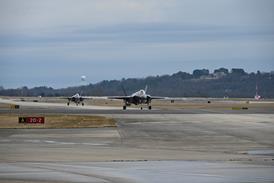Boeing's newest aircraft, the Boeing 717 - dubbed the best solution for the growing 100-seat market by chairman and CEO Phil Condit - makes its European debut at Le Bourget.
Boeing inherited the 717 as the MD 95 following the takeover of McDonnell Douglas. It is the direct successor to the DC-9.
While speculation was rife that Boeing would axe the programme, workers at the company's Long Beach, California plant continued to work on the design and developed an aircraft that has already met with enthusiasm by launch customers.
"I am an optimist," says Jerry Callaghan, the director for 717 development. "It is a good aircraft. The project had to continue."
He estimates the market for this aircraft at around 2,600 units over the next 20 years.
Delivery
The 717-200 had its first flight during the Farnborough air show and is now heading toward certification and first delivery in September.
The aircraft on display in Boeing's corporate colours will continue after Le Bourget on a 10-day tour of seven European countries, visiting airlines in nine cities before returning to Long Beach before being modified in preparation for delivery to launch customer AirTran Airways in September.
Callaghan says the results from the four development aircraft have been outstanding.
The company announced in April that the twinjet was exceeding fuel burn performance targets. Since then, in logging hundreds of additional hours the 717 is still beating cruise altitude performance levels by up to five per cent.
"In climb we are achieving better-than-expected results with something like two and a half per cent," Callaghan says. "Our cruise weight is better, noise levels are less and we have improvements on the targets for all of the new ICAO regulatory limits such as NOx emissions, noise and carbon monoxide.
Tough
"This is an aeroplane that will meet all of the tough environmental requirements."
Boeing is full of praise for its European powerplant partners, BMW Rolls-Royce, whose 715 engine was developed for the 717 and modified by the German-based company to meet requests from mechanics who have worked with Boeing in developing the aircraft.
"They were great to work with," says Tom Croslin, the project's chief design engineer. "We had none of that 'Not Invented Here' attitude from BMW Rolls-Royce or any of the other suppliers we worked with.
"We involved mechanics, flight attendants, engineers and pilots in all of the development stages. What we have in an aircraft that is functional and easy to work on.
"It is the small things that have made a big difference," Croslin says - small things such as a single switch that allows flight attendants to turn off all of the reading lights and call buttons at the end of a flight - and turn them on again to check they are all working; a three stage coffee cup holder for the flight deck and somewhere to put pencils; modular overhead bins that allow passengers to stow trolley bags and a brief case; standard lights that can be changed without the need for tools; window shades, inner and outer panes that can be changed without the need to remove seats; and reading lights that can easily be serviced by cabin crew.
"Simple things," says Broslin, "But when you add them up it makes the aircraft more economic. It is quicker to turn around (20 minutes) and we have the lowest cost, highest reliability and unmatched cabin comfort."
Manufactured
While Boeing officials talk about the aircraft coming to Europe for the first time, they are really only talking about half of it since some 40% of the aircraft was manufactured in Europe.
As well as the engines from Germany the interior is from Fisher Advanced Composite Components of Austria; the fuselage from Alenia of Italy and the wiring from Labinal of France.
Other non-US suppliers to the 717 include: Aerospace Industrial Development Corp of Taichung, Taiwan (empennage); ShinMaywa Industries of Tokyo (horizontal stabilisers and pylon); Hyundai (wiring) and another Korean firm, Korean Aerospace (nose). The landing gear was built by Israel Aircraft Industries.
There was also a large US involvement: AlliedSignal (avionics and pneumatics); Honeywell (flight guidance); Parker Hannifin (controls); Sundstrand (electrical); Auxiliary Power International (APU); Marconi Flight Systems (wing join); BF Goodrich (nacelle).
The concept of using customer focus teams is not new but Boeing has worked hard at employee involvement - and that has made a difference.
"I guess we all know that if you want to know what the problems are you talk to the guys on the shop floor," says Callaghan. Boeing took this a stage further by developing Accelerated Improvement Workshops (AIW) among workers who solved a number of the development problems and made suggestions that the company estimates has shaved millions from the costs.
Pride
"They are involved. They have pride in the aircraft and were ready to look at new ways," says Callaghan. This, combined with use of the latest technologies in laser assisted assembly has also improved speed of production.
Boeing estimate 12 deliveries through the end of 1999; 33 in 2000 and then 62 aircraft a year after that.
The order books are full through to the end of 2001 with orders for 50 aircraft plus options on a further 50 from both TWA and AirTrans, plus 10 orders and options on another 10 from from Pembroke Capital and five firm orders from the Bavarian lease company.
Source: Flight Daily News























